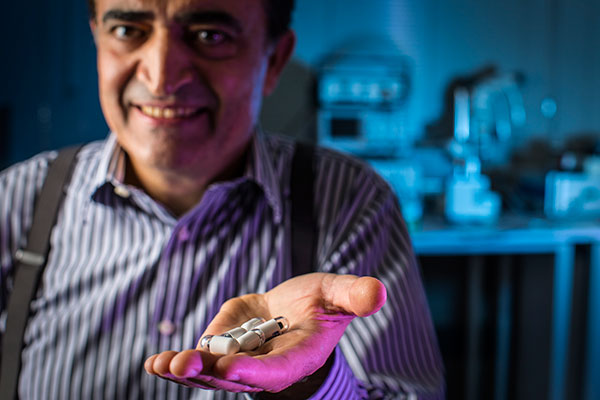April 27, 2015
Capsule robot a better pill to swallow
A robotic drug capsule could pave the way for pain-free detection and treatment of gastrointestinal diseases.

A team of UOW researchers led by Professor Gursel Alici (pictured above), Head of the School of Mechanical, Materials and Mechatronic Engineering, is developing a capsule that can be magnetically “driven” through the body to examine a patient's gastrointestinal tract and deliver drugs directly at the treatment site.
This will allow physicians to screen and treat gastrointestinal tract diseases including internal bleeding, Crohn’s disease, small bowel tumours and coeliac disease. Current endoscopy procedures involve inserting a long flexible tube with a camera lens on one end into a patient’s body.
“These procedures are painful and cumbersome and the patient has to take special medication to clean the gastrointestinal tract,” Professor Alici said.
In some cases, mainly to pinpoint bleeding in hidden areas in the small bowel, a pill-like capsule is swallowed and it contains a small camera to capture images inside the body, which can be transferred wirelessly and in real-time to the physician to help with diagnosis.
Though the endoscopic capsule used widely by physicians has a few major limitations: it relies on muscle contraction and expansion to travel through the body, much like a piece of food, and its direction can’t be controlled.
Patients have probes taped to their abdomen to track the movement of the capsule, but it is difficult to locate and pinpoint the precise location of tumours and other suspect tissue.
This limits the physician’s ability to return to suspect sites for re-inspection or follow-up interventions such as drug delivery or surgical operations.
Professor Alici’s team started work in 2010 to improve the existing endoscopic capsule to enable its passage through the body to be controlled, located as well as adding therapeutic capability, such as targeted drug delivery to directly treat the affected tissue.
“By using magnetic forces, the system is wireless, its clean and site-specific drug delivery limits the side-effects on the body,” he said.
“This capsule we are developing can be ingested and the patient can continue with daily activity. It’s also more accurate and can reach all parts of the gastrointestinal tract.”
Professor Alici’s team found by wrapping the capsule with hard and soft wire coils and applying a magnetic force they were able to drive it through a pig intestine.
“By using a rotating magnetic field the capsule spins about its axis and the spiral structure of the coils turns that rotation into movement.
“Other tests have used silicon pipes filled with oil to mimic the complex environment of the intestinal tract. This is the first time this technique has been tested in a real small intestine.”
In the next phase of the research the team embedded tiny markers in the capsule to help precisely pinpoint its location in the body.
This novel localisation technique, tested in two commercial PET scanners, is the most accurate reported to date in the research literature.
To deliver drugs at the site the team developed an anchoring system that expands and attaches the capsule to the gastrointestinal tract tissue before delivering the drugs.
Once the capsule is anchored, another magnet activates a slider that ejects the drugs so that they can absorb into the treatment site.
“The drug delivery mechanical system provides control over the drug release, dosage amount and even multiple doses from a single capsule,” Professor Alici said.
Professor Alici said future developments would be aimed at enabling the capsule to take a biopsy (a sample of tissue) directly from site without the need for an endoscopy.
“Such an actively controlled and precisely located robotic capsule with diagnosis, drug delivery, minimally invasive surgery and biopsy features will eventually be used in real life clinical practice to provide an effective healthcare to the society,” he said.
The research team consists of Professor Gursel Alici, Professor Weihua Li, Dr Steven Harvey and PhD students Hao Zhou, Trung Than and Fredy Munoz.


